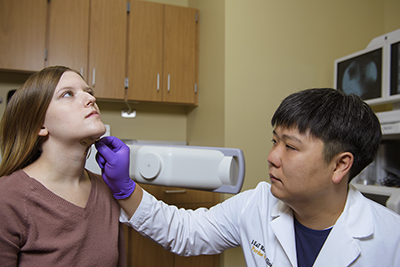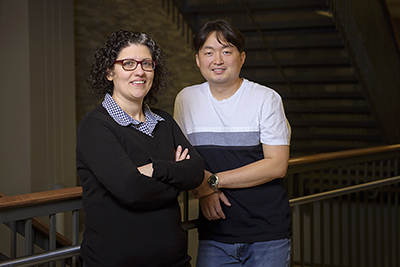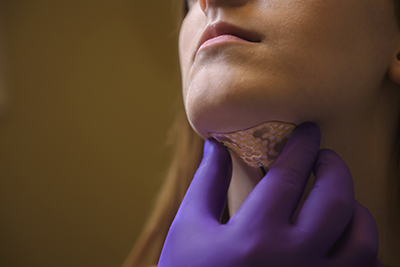Wearable and affordable, device targets swallowing disorders
Professor Malandraki’s team develops way for remote monitoring of dysphagia
Story by Phillip Fiorini and Linda Thomas
In her native country of Greece, Purdue professor Georgia Malandraki saw firsthand that resources for swallowing disorders were extremely limited. That only fueled a passion to explore how to improve access to care for what’s known as dysphagia to as many people as possible.
 Min Ku Kim, a PhD student in biomedical engineering, attaches a wearable sticker-like sensor patch developed by Drs. Georgia Malandraki (from HHS and SLHS) and Chi Hwan Lee (BME and ME) to a subject's neck. The sensor wirelessly monitors activity of the neck muscles when someone swallows and completes their swallowing therapy exercises.
Min Ku Kim, a PhD student in biomedical engineering, attaches a wearable sticker-like sensor patch developed by Drs. Georgia Malandraki (from HHS and SLHS) and Chi Hwan Lee (BME and ME) to a subject's neck. The sensor wirelessly monitors activity of the neck muscles when someone swallows and completes their swallowing therapy exercises.
Malandraki, an associate professor of Speech, Language, and Hearing Sciences, is collaborating with Purdue colleague Chi Hwan Lee, an assistant professor of Biomedical Engineering and Mechanical Engineering, to develop a wearable sensor that monitors swallowing and transmits data to clinicians, helping advance treatment of the devastating consequences of dysphagia.
Each year, an estimated 10 million adults and 500,000 children in the United States are diagnosed with swallowing problems caused by neurologic disorders. Dysphagia, or swallowing disorders, is estimated to affect up to 22% of adults over 50, as well as stroke patients and children with cerebral palsy among many other populations.
Untreated or ineffectively treated dysphagia can lead to malnutrition, dehydration, pneumonia from aspiration of foods and liquids into the lungs, or even death, says Malandraki, who developed the sensor through her Imaging, Evaluation and Treatment (I-EaT) Swallowing Research Lab at Purdue’s Lyles-Porter Hall. Infants might experience problems with the coordination of sucking, swallowing and breathing while nursing or bottle feeding and, ultimately, failure to thrive.
“We want to provide a reliable, patient-friendly and affordable way to treat the millions of people with swallowing disorders,” says Malandraki, a 2019 recipient of the College of Health and Human Sciences Early Career Research Achievement Award. “Many devices to help these people are expensive, can’t be taken home and are not accessible in many rural areas. Especially with today’s pandemic crisis, it becomes clear that the need for optimized telehealth solutions is more urgent than ever.”
 Georgia Malandraki and Chi Hwan Lee founded Curasis LLC to commercialize their wearable technology to help people with swallowing disorders.
Georgia Malandraki and Chi Hwan Lee founded Curasis LLC to commercialize their wearable technology to help people with swallowing disorders.
Swallowing disorders can affect anyone and this video shows the difference between normal and abnormal. But children, including infants, especially those born prematurely, and older adults with age-related disorders such as Parkinson’s disease, are the most susceptible, Malandraki says. Swallowing disorders also are common in patients affected by stroke, cerebral palsy, traumatic brain injuries and head and neck cancer.
“What we often say is that these are not visible disorders. Someone with a swallowing disorder might be speaking and walking fine but could have a tube in their stomach just to help them nourish themselves and survive, and you would never know,” she says.
Dysphagia extends beyond physical health. The psychological effects that often accompany it can be devastating.
“Dysphagia is a very isolating condition,” Malandraki says. “All of our social events — weddings, parties, even funerals — are centered around food and drinks, and when you can’t eat or drink, it really isolates you. Our patients frequently deal with depression and don’t want to leave the house.”
Successful completion of a swallow requires the precise coordination of 30+ pairs of muscles of the head and neck, six pairs of cranial nerves, and complex circuitry in the brainstem and several brain areas. Any pathway disruption can result in severe swallowing disorders.
“I want to help patients be able to eat and grow, nourish themselves,” Malandraki says. “Being able to help someone survive or help make the difference between whether they live or die is something extraordinary. It is a heavy responsibility but also an enormous privilege I don’t take for granted. Our mission is to find effective ways to rehabilitate swallowing so that we help people live long, healthy and happy lives.”
Patent pursuit for broader benefit
Malandraki and Lee have completed preclinical tests of the device and are currently conducting clinical trials. The first of several related patents has resulted in a prototype device known as the Tele-EaT sensors system, which is being commercialized through the startup company Curasis.
This non-invasive, wearable and affordable surface uses electromyographic and other sensors to monitor swallowing by recording high-quality muscle activity signals from the challenging curvilinear head and neck area. Patients can wear a sticker-like patch that conforms to the skin, perform their swallowing exercises and receive immediate critical feedback via an app — all from home.
 A close up of the wearable sticker-like sensor patch attached on a subject's neck.
A close up of the wearable sticker-like sensor patch attached on a subject's neck.
Malandraki and Lee’s team are working with the Purdue Research Foundation’s Office of Technology Commercialization on patenting their technology. They also worked closely with the Purdue Foundry, a commercialization hub in Discovery Park’s Burton D. Morgan Center for Entrepreneurship.
“Our device is unique in that we specifically created it to work well with the small and intricate muscles associated with swallowing events,” Lee said. “The sensor sticker is stretchable and flexible to work well with the skin and curvilinear head and neck shape, while the connected unit has electronic chips and more rigid components.”
— Contributing to this story: Abbey Nickel, nickela@purdue.edu
More Life 360 Stories
Milestones
Alumni
- Model Behavior
- On the Frontline of COVID-19
- Alumni making giant leaps in health care, aviation industries
- Tradition Transformed
- Emerging Leaders
Research
- Wearable and affordable, device targets swallowing disorders
- Evolution of a Research Relationship: From PhD Student to Peer
- Rapid Response Grant Recipients
Faculty
- Wearable and affordable, device targets swallowing disorders
- Beware the ‘quarantini’
- Safe and sustainable tourism in times of COVID-19
- Building a Community of Support
- Adapting Online … in a Hurry
- Thinking Beyond the Pandemic
- Rapid Response Grant Recipients
- Risk & Resilience: How the Pandemic Affects Those with Special Needs
Students
- Evolution of a Research Relationship: From PhD Student to Peer
- On the Frontline of COVID-19
- Tradition Transformed
- Adapting Online … in a Hurry
- Pandemic Pivot brings Gen Zs and Baby Boomers together in unique way
- HTM students learn and build community
- Emerging Leaders
